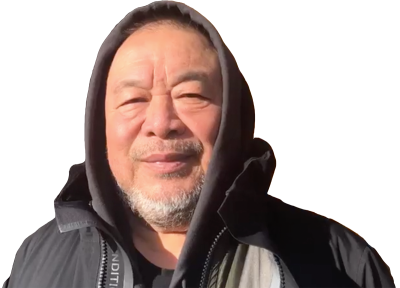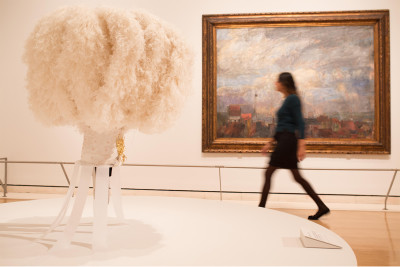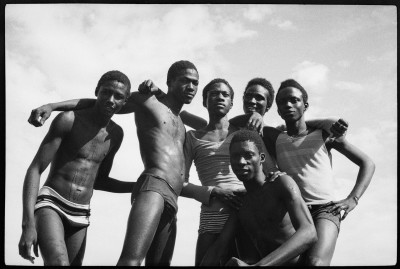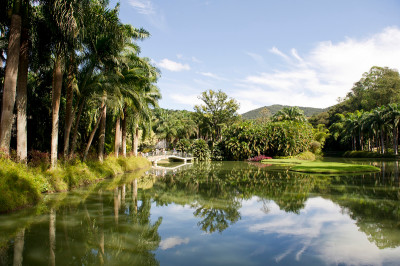In the neighbourhood: Ai Weiwei’s ‘village’ in Beijing
In the neighbourhood: Ai Weiwei’s ‘village’ in Beijing
Behind the scenes
By Adrian Locke
Published 1 April 2015
A vibrant arts quarter has grown up around Ai Weiwei’s home and studio in Beijing. Our curator Adrian Locke explores the area, and finds himself on a journey into the city’s past.
-
Part four in a series of blogs telling the story of how our forthcoming Ai Weiwei exhibition – the latest in our sequence of major single artist shows – is being put together across 10 months, by teams across three continents.
Three days in to my first visit to Ai Weiwei’s studio in Beijing, I took a walk through the ‘village’ of Caochangdi in the Chaoyang district of Beijing, the area in which Ai Weiwei built his house and studio compound in 1999. I was accompanied by John Tancock, who is working on the vast project of cataloguing Ai Weiwei’s photographic archive. It is a quiet time of the day and everything feels rather sleepy as we wend our way through narrow dusty streets lined with small shops and intimate eating places. No through traffic is allowed so it is wonderfully relaxed.
After Ai Weiwei built his own studio here, a number of artists and galleries followed suit, creating a cultural neighbourhood in an area that has escaped the relentless development of Beijing. Ai Weiwei has long lamented the loss of the traditional courtyard houses clustered on the traditional hutongs or narrow alleyways and streets that were characteristic of Beijing. Now only a few remain, clustered around the Forbidden City, part of every tourist itinerary. Being in Caochangdi feels like catching a glimpse of the real China hidden amongst the skyscrapers and bustling avenues of the modern city that have engulfed it.
Spending time in this area, I am reminded that much of Ai Weiwei’s work serves to remind us of a past that has become overshadowed, where traditions have been lost, revealing the hidden cost in both human and cultural terms of modernisation, and the seemingly relentless pace of change that has driven China’s economy, making it a global giant over recent years. Our exhibition at the RA will explore the questions that Ai Weiwei raises about this loss.
-

A covered market in the Caochangdi neighbourhood

Galerie Urs Meile in Beijing

A thick, dust-like layer of pollution on a car parked in the hutongs of Beijing

Three Shadows Photography Art Centre in Beijing
-
Chambers Fine Art, the commercial gallery where we had lunch, is located in the Red Brick Art Galleries and Studios (pictured at top), a dramatic complex with narrow brick-lined paths leading past red brick buildings that Ai Weiwei designed. Built in 2007, it creates an austere, industrial environment without people. Quiet during the week, the galleries are a popular weekend destination.
From there, we walked through a small covered market, live fish gazing languidly up from a bucket, towards the Galerie Urs Meile – another building designed by Weiwei and completed in 2005 using the traditional grey bricks of much of the old Beijing. This gallery sits behind a brick wall with subtly landscaped gardens providing an oasis of green among the dusty streets; the pollution in Beijing leaves a thick dust over all the cars in the street, as if there has been a recent volcanic eruption, and the lush grass provides a startling colour contrast.
Finally we wound our way to the Three Shadows Photography Art Centre, crossing the Nan Gao Road in the process. This major complex, another of Ai Weiwei’s designs, is marked by the patterned walls created by his playful design that animate the exterior brick walls. Like many of Ai Weiwei’s designs, the interior spaces play with variations in height and the exaggerated angles of the walls.
It was here, in 2009, that Ai Weiwei had an exhibition of the photographs he took during the twelve years he lived in the USA, mainly in New York. John pointed out the poster from a number that recorded the various exhibitions at the entrance to the gallery. As he did so he added soberly that it is a sad reality that that particular exhibition could never happen now given the hostility that Ai Weiwei faces from the authorities in China.
Despite being Chinese, working in China and addressing Chinese issues, Ai Weiwei simply does not exist as an artist in his home country. This makes it all the more important that we are able to showcase his work in exhibitions such as ours at the Royal Academy.
Ai Weiwei is in the Main Galleries from 19 September — 13 December 2015.







